It was where seven worlds could collide, from big bands to punk. Durham Street West was ground zero for popular music in Auckland for many decades: it was the heart of Auckland’s music precinct in the central city. Durham Street was more of an alley than a street, and the narrow space was dominated for nearly 50 years by an Art Deco masterpiece: Auckland’s Broadcasting House, purpose-built and designed with great flair in 1939 when radio promised a brave, new world.
For most of its life, Broadcasting House overlooked His Majesty’s Theatre, beloved from First World War concerts to the Split Enz extravaganzas in the 1970s. In that decade, the radio hub was adjoined on Durham Lane by Granpa’s, a nightclub that once hosted the Rolling Stones before evolving into Zwines, punk mecca. Across the street was Record Warehouse, the hippest store of the era.
Broadcasting House was a modernist statement, designed in Art Deco style by architect Alva Bartley. His client was the National Broadcasting Service, established in 1936. The director-general James Shelley wanted a building that epitomised the goals of public broadcasting: to enlighten, educate, and entertain. All to the highest possible standards.

- Auckland Libraries Heritage Collections 915-Album-148-1
Besides being the home of 1ZB and 1ZM for many decades, Broadcasting House contained the Radio Theatre, where countless concerts, plays, variety shows, quizzes and musical comedies were broadcast live or recorded for later airplay from an acetate or magnetic tape.
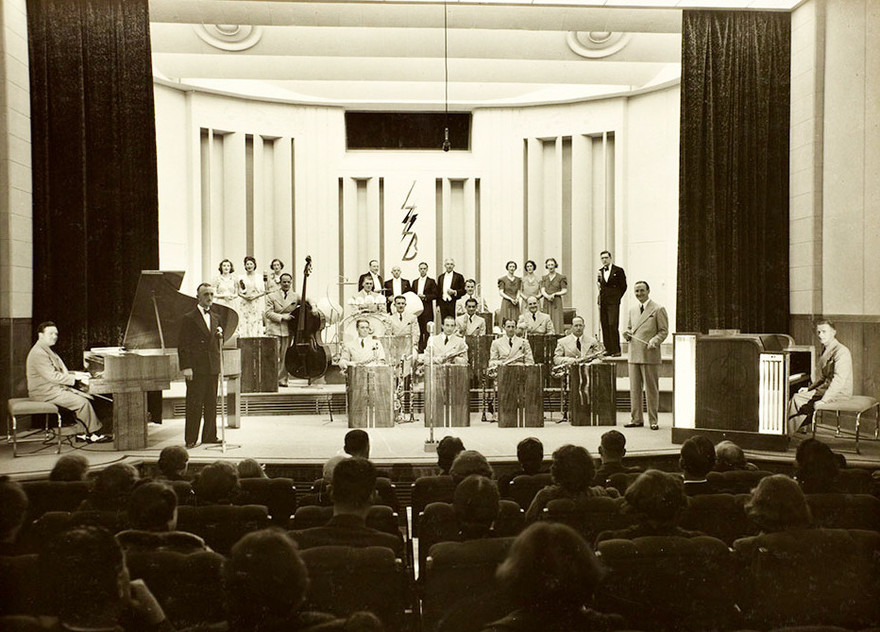
- Auckland Libraries Heritage Collections 915-Album-148-19
By the time Broadcasting House opened in October 1941, World War II had been underway for two years. Opening night featured music by Theo Walters and his Radio Theatre Dance Orchestra, aka “the 1ZB Orchestra”. Walters was offered a three-month contract by 1ZB to provide a band to play every night; the fee was then the highest yet for a dance band. Swing was Walters’s thing, “modern music which causes listeners to feel a definite urge to dance.” He admired Benny Goodman’s style; Duke Ellington was too futuristic, Cab Calloway too raucous. In this photo, Walters holds his baton; at the piano is Len Hawkins; beside him is the compere/musician, Reg Morgan; at the neon-lit Novachord on the right is Eric Bell.
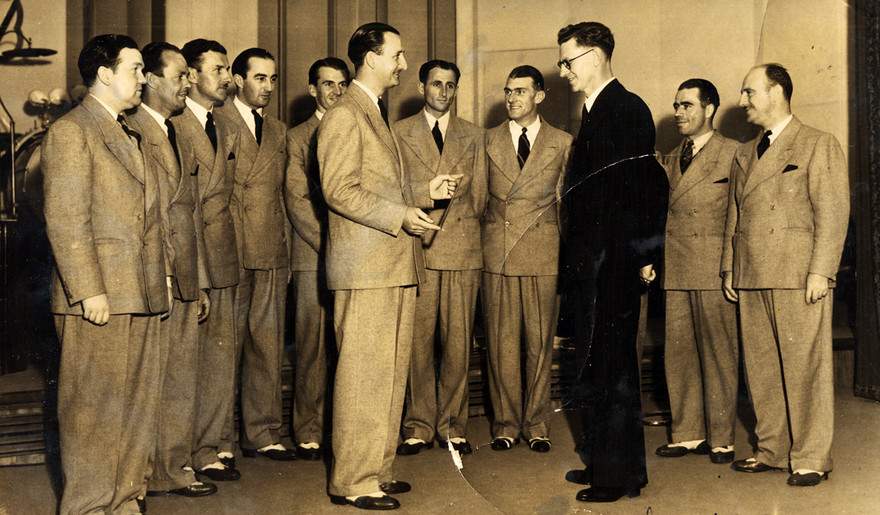
- Stan Hills collection
Also performing at the opening was Ana Hato, whose pioneering recordings of Māori music in the late 1920s were still selling well. The host was the controversial broadcaster Colin Scrimgeour, the manager of the NCBS, the commercial service of the public broadcaster. In this photo Scrimgeour is being given a presentation baton by Walters, whose impeccably dressed orchestra stands to attention in matching wide-lapelled suits, two-tone shoes, and hair oil. The musicians are, from left: Len Hawkins, Harry Unwin, Allan Hills, Jimmy Watters, Brian Marston, Theo Walters, Norm Egerton, Fred Gedson, Colin Scrimgeour, Phil Campbell (obscured), Gordon Lanigan, and Bill Pritchard.
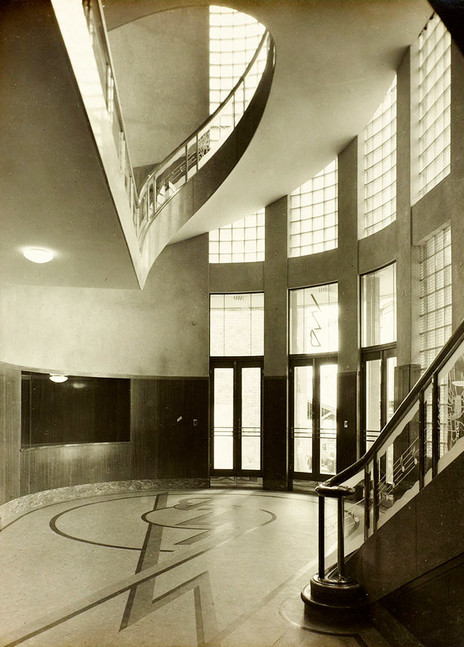
- Auckland Libraries Heritage Collections 915-Album-148-7
Let’s make our way inside from the Durham Street entrance, which is lit by a corner wall of glass bricks. 1ZM’s logo and a quaver are etched into the marble floor, and the staircase leads to the exotic world of the wireless on upper floors.
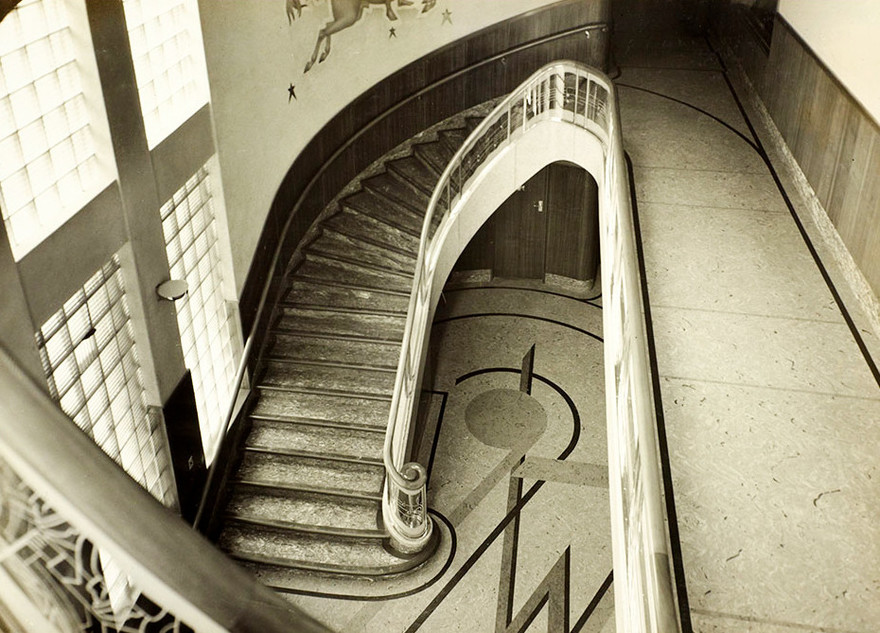
- Auckland Libraries Heritage Collections 915-Album-148-9
The grand, curved staircase is reputed to be designed in the shape of a treble clef.
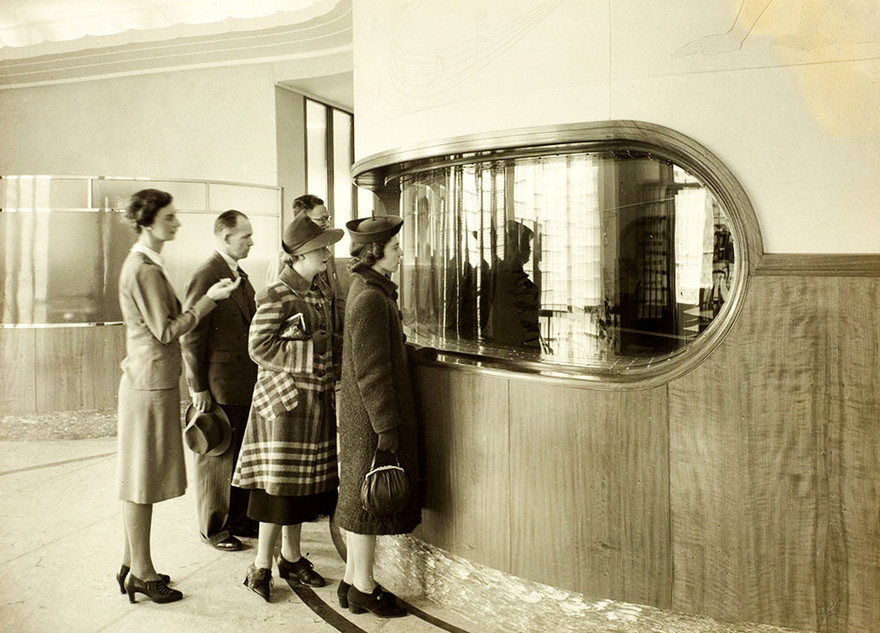
- Auckland Libraries Heritage Collections 915-Album-148-15
On the upstairs landing, the theme of curved fittings carries through to the internal windows, through which visiting listeners could watch their favourite radio hosts speak into their ribbon microphones, dressed for dinner, in studios fitted out like living rooms. Like the wooden valve radios around which families gathered, the broadcasters were guests inside the listeners’ homes.

- Auckland Libraries Heritage Collections 915-Album-148-35
A white baby grand for live-to-air recitals, broadcast through an RCA ribbon microphone. Note the curved studio window, drummer-boy carpet design, and the requisite deco-era vase of fresh lilies.

- Auckland Libraries Heritage Collections 915-Album-148-17
Into the Radio Theatre auditorium, an intimate space that could fit just over 100 guests sitting in plush armchairs. This view from the stage shows the 30s-era boudoir grand piano, and curved music stands made from laminated wood or chrome metal. Hanging from the ceiling are microphones to capture ambience.

- Auckland Libraries Heritage Collections 915-Album-148-20
A closeup of stage left, showing the walnut-veneered boudoir grand, and a full drum kit equipped with percussion accessories fashionable in the 1930s.
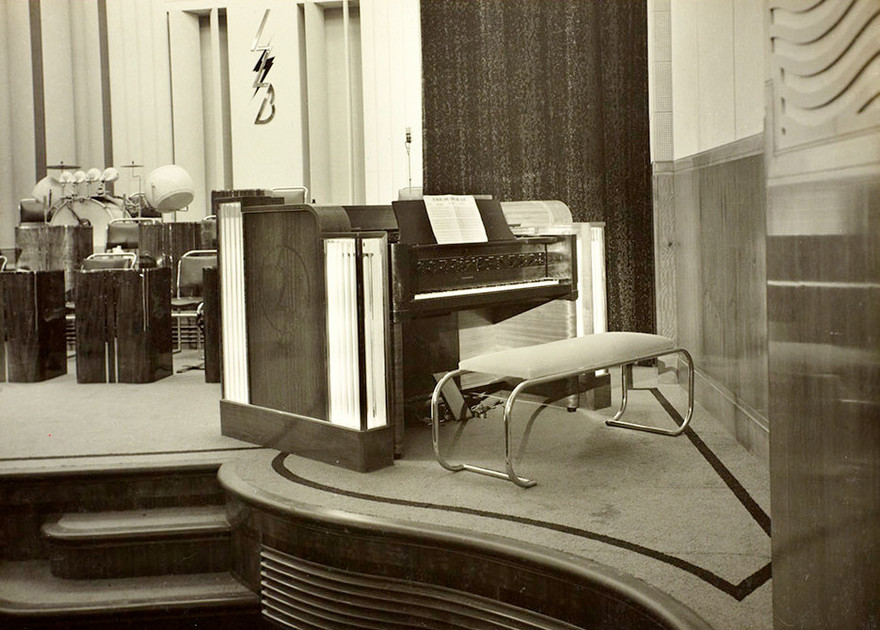
- Auckland Libraries Heritage Collections 915-Album-148-21
Taking pride of place in the Radio Theatre for its first 20 years was the Novachord, a new keyboard instrument that was a precursor to the synthesiser. Designed by the Hammond organ company in 1939, it was like an orchestra in a box. In place of pipes and pedals, it had a single five-and-a-half octave keyboard. All electric, its 167 valves could reproduce the sounds of almost any instrument – or combination of instruments. 1ZB’s master of the Novachord was Eric Bell, who was featured playing the instrument in countless programmes broadcast throughout the country. Above the keyboard were many switches that created the combination of sounds to emulate the tones of other instruments. Bell became very adept at meeting challenges, playing the Novachord as a straight church organ then converting the sound to, say, a cello and violin duet.

- Auckland Libraries Heritage Collections 915-Album-148-30
Recitals, talks, and live drama could be broadcast from several luxurious studios, each of which was fitted with armchairs and Art Deco ashtrays.
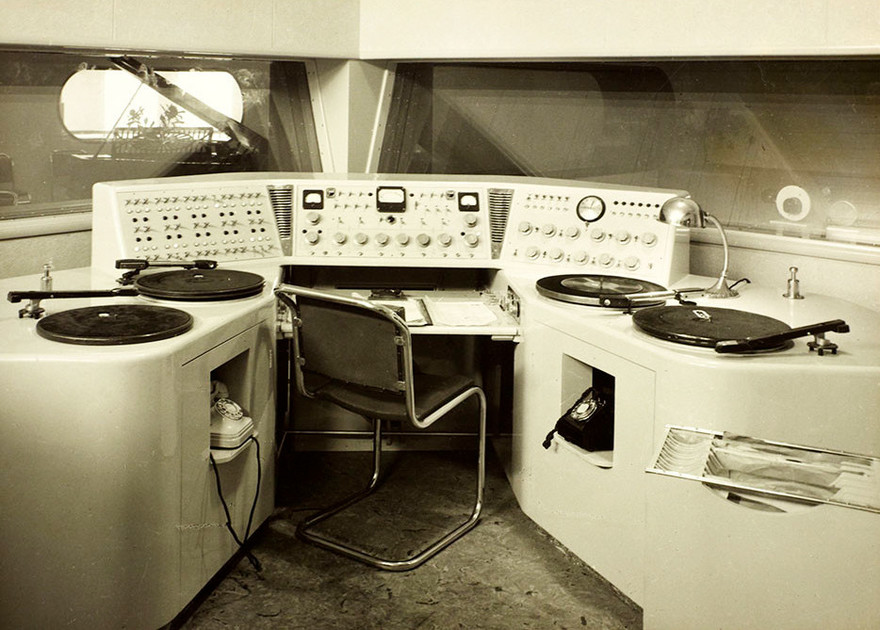
- Auckland Libraries Heritage Collections 915-Album-148-33
There were several control rooms, more from the Hindenburg airship era than the space age. Controlling what went on through the curved glass were mixing desks with large pots and sensitive VU meters (which never went into the red). There were four turntables to stay on top of the fast-spinning 78rpm discs (no time for a DJ toilet break while songs played). Plus, two rotary telephones: one to talk to the studio, the white one perhaps to take irate phone-calls from director-general Shelley when a jazz disc made it to air.
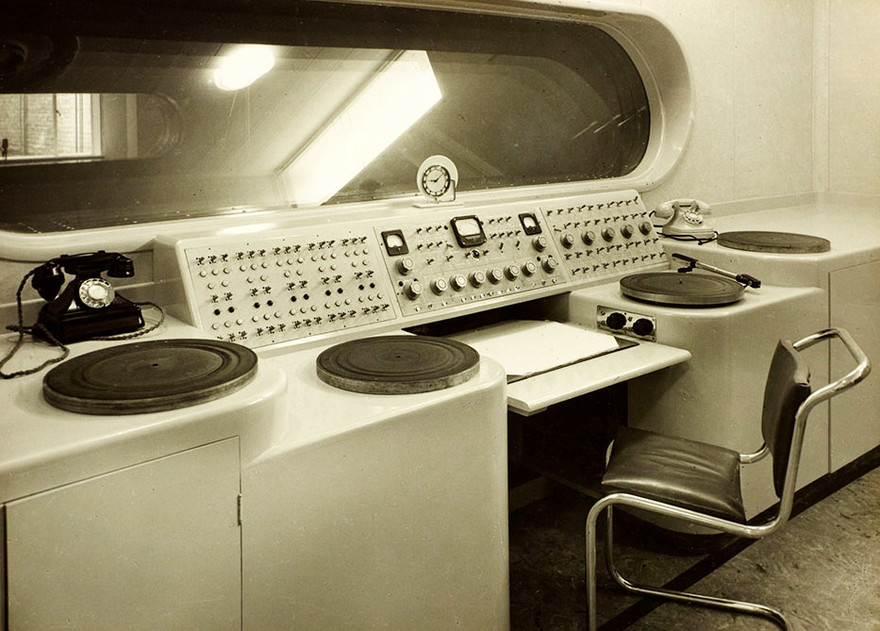
- Auckland Libraries Heritage Collections 915-Album-148-34
Another control room, ready for action at five past nine in the morning, sunlight streaming through from Durham Lane.

- Auckland Libraries Heritage Collections 915-Album-148-28
1ZB’s programming section, and part of its record collection of 78rpm discs, from classical to swing.
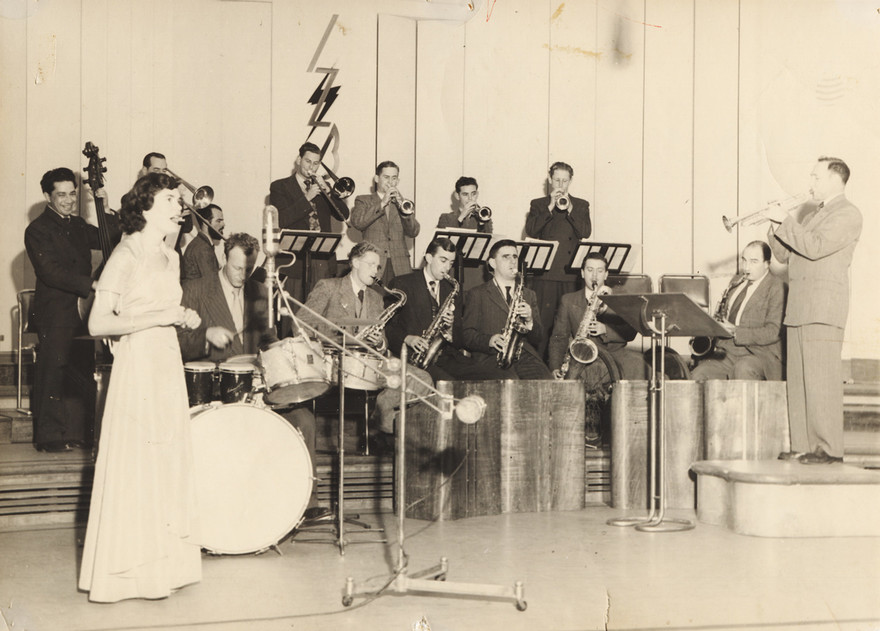
- Bernie Allen collection
Immediately after the war the Radio Theatre hit its stride for live music broadcasts, which lasted until the 1970s. Here, the 1ZB dance band backs Auckland singer Esme Stephens in the Radio Theatre, early 1950s. Stephens is best known for her hits ‘Between Two Trees’ and ‘Mixed Emotions’, recorded at Stebbing’s at the time of this photo; she also sang with Artie Shaw’s Navy Band during the Auckland leg of its 1943 visit to New Zealand. Beside her is a star rhythm section, bassist George Campbell and – in front of the band – Frank Gibson (Sr) on drums. Also in the band is a young, bearded Crombie Murdoch on piano, and Julian Lee on saxophone. Back row: Bob Davis, Dale Alderton, Murray Tanner, Neil Bruce, Heck Dainty. Front row: Norm Powell, Colin Martin, Julian Lee, Pem Shepherd, Jim Watters. Standing: Bob Leach.
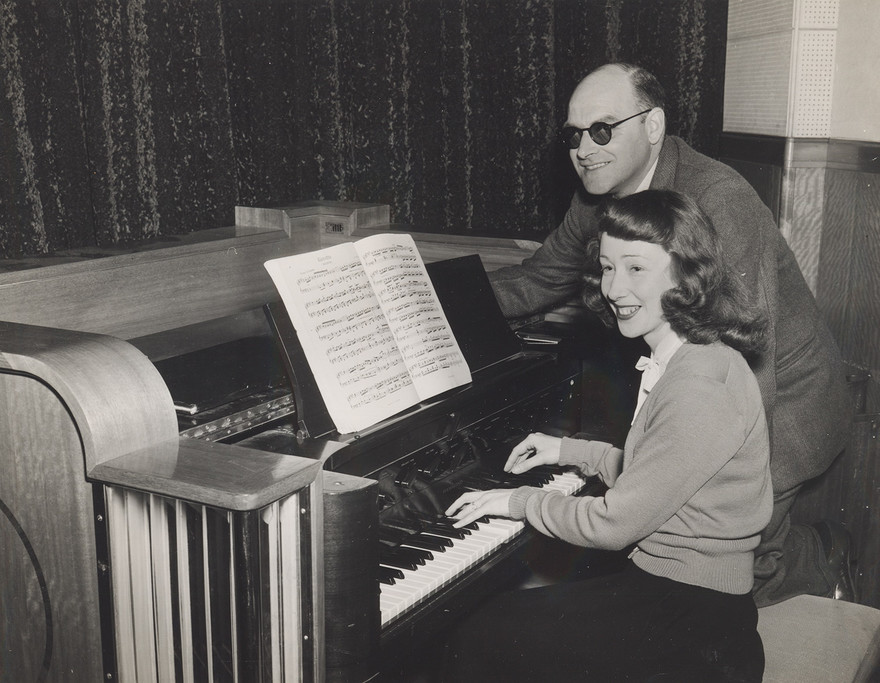
- RNZ Sound Archive
Testing the Novachord are regular radio pianists Nancy Harrie and John Thomson. Born in Ngāruawāhia, for 30 years Harrie was in demand for recording and broadcasting sessions. She was a rarity, a female musician in a male world, who survived through her talent and sense of humour. Harrie’s style could be florid or spare: she was just as happy providing the rhythm for a big swing band or a Latin combo, as she was sliding grace notes behind a country and western tune. Here, Harrie and Thomson are preparing for the 1952 programme Keyboard Capers.
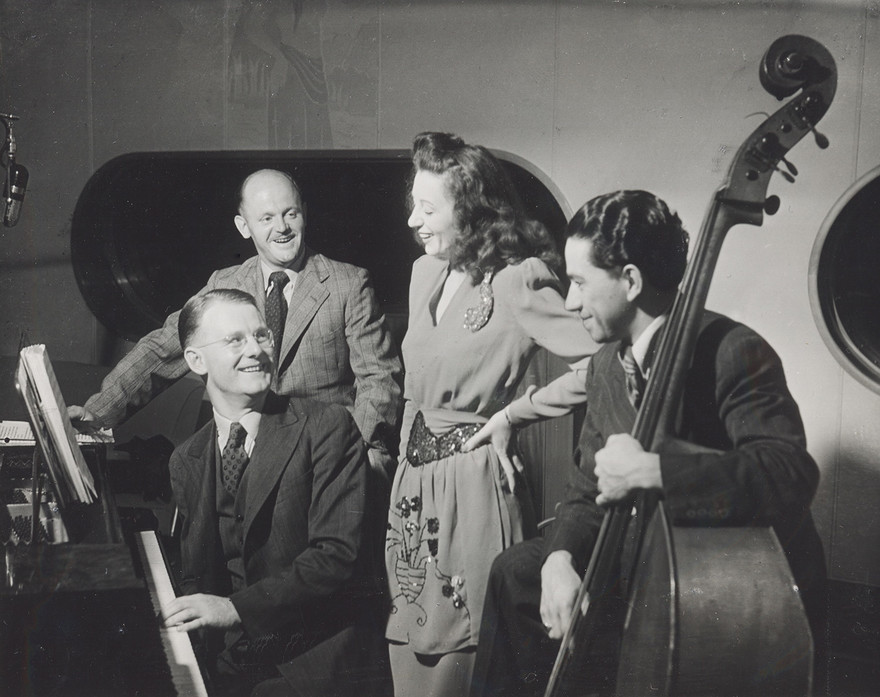
- RNZ Sound Archive
Marion Waite was a war bride from the US who settled in New Zealand and became a star singer in the late 1940s. “I don’t go in for this ‘jive’ business, which is too rough and noisy for me,” she told the Listener in 1945. “I am known at home as a ‘sweet swing’ and ‘blues’ singer.” With her are, from left, pianist John Parkin, drummer and MC Wally Ransom, and bassist George Campbell.
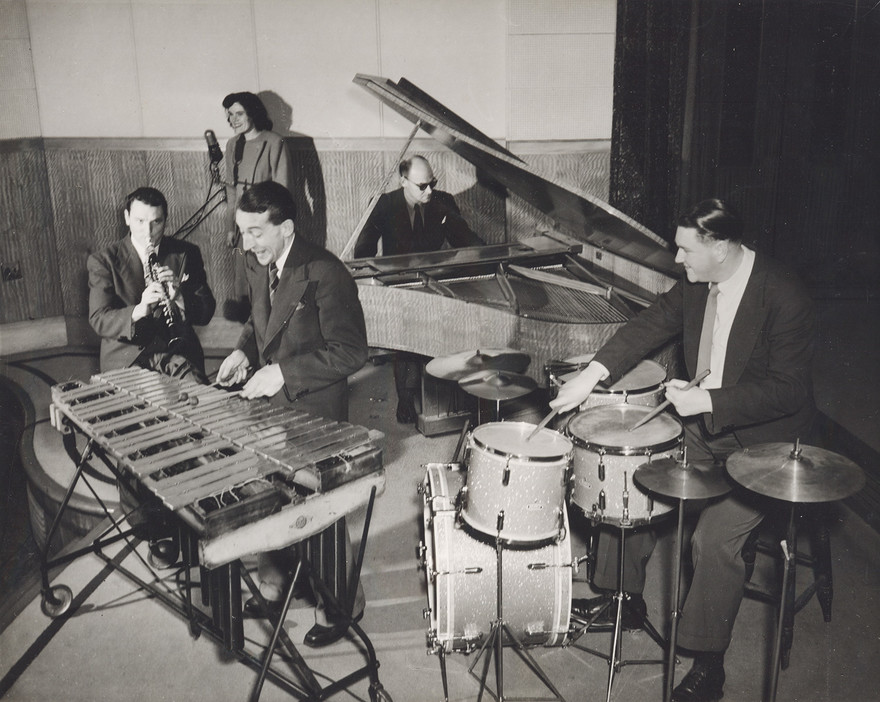
- RNZ Sound Archive
Seen here recording in Broadcasting House c. 1947 is Harry Wicks, a very skilled vibraphonist who led his own small combos in Auckland during and after World War II. Among the wartime venues his band appeared at was the Club Silver Slipper on Fort Street, Auckland. The vocalist is Esme Stephens; on clarinet is Reg Gould, who led the band at Auckland’s smart Metropole cabaret during the war; the drummer is thought to be Barrie Simpson, a member of Chips Healy’s Civic Wintergarden band. The pianist is Johnny Thomson, who led his own bands in Auckland clubs and served with the RNZAF during the war. This is a publicity shot for the combo’s pre-recorded broadcasts on the YA stations.

- Auckland Libraries Heritage Collections 915-Album-148-22
Just before 7pm on Saturday nights in the 1950s, the 1ZB Radio Theatre in Auckland would be packed with people, the air heavy (to quote Phil Gifford) “with the scent of Palmolive hair oil and Three Flowers perfume”. The crowd would have formed an early queue outside in Durham Street to ensure a seat for the weekly 30-minute live broadcast on 1YD by a radio dance band: a free show starring the cream of Auckland’s dance and jazz musicians.
The radio dance band system, set up by Bob Bothamley, Broadcasting’s “head of dance”, ran like a well-oiled machine from the late 40s until the 1960s. Every four months – in each of the four main centres – a new radio band began a contract for play a live broadcast each week. For these broadcasts and a rehearsal the musicians were paid £3/7/6. When it was time to offer another band a contract, there would be a shuffling of musical chairs, with the bandleaders and arrangers taking a seat among the rank-and-file when their stint was over. Bothamley was described as “scrupulously honest,” but in effect the radio bands were a closed shop of the elite musicians.
The system gave valuable arranging experience to a host of young bandleaders. Musicians such as Crombie Murdoch, Julian Lee, Lew Campbell, Freddie Gore, Don Richardson, Brian Marston, Dorsey Cameron, Doug Caldwell, and Calder Prescott seized the opportunity to find their own musical voice with their chosen line-ups. Vocalists included Mavis Rivers, Esme Stephens, Coral Cummins and Marion Waite. As well as providing an outlet – and income – to the best young musicians and arrangers, the post-war radio bands became familiar with the studio, which proved valuable when the recording industry got under way in the 1950s. By the 1960s a new generation of jazz musicians was taking part, among them Tony Baker, Bernie Allen, Merv Thomas, Neil McGough, Bob Gillett, Bruce King, and Jimmie Sloggett.
In the 1970s, a seismic shift would see Auckland’s Broadcasting House studios hosting “as live” recording sessions of rock bands, for later broadcast on RNZ’s pop stations. Among the bands which made their earliest recordings in the art deco space were Street Talk, Hello Sailor, and Th’ Dudes.
But what of the magnificent building? There was criticism, of course, when it opened in October 1941, that the Labour government had proceeded with its construction once the war began. After all, a grand broadcasting centre planned for Wellington had been abandoned, and the Auckland building cost £80,000 (the equivalent of $7.5 million in 2019 dollars). At the opening, the minister of broadcasting, David Wilson – a tailor and unionist from Scotland – said that 1ZB Broadcasting House was essential “because of the unhealthy and very uncomfortable conditions under which the 1ZB staff had to work.” Broadcasting’s other premises in Auckland were most unsuitable for making use of the very good local talent available, he said. “It is my policy to develop local talent to the furthest limit in the future, and these new facilities will assist in this direction very materially.”
Almost 50 years later, the tide turned. In 1985 Paul Holmes began his long run as host of 1ZB’s breakfast show. “We all know the importance of historic buildings,” he wrote in 2010. “We all know the marvel of so many of them around the world. And we know how much heritage Auckland lost and we know the hideousness of so much modern construction that has been allowed to rise on our skyline.
“Look, I remember doing the breakfast programme on Newstalk ZB from the old Broadcasting House in Durham Lane when David Phillips had his vandals right next door demolishing His Majesty’s Theatre and His Majesty’s arcade.” His Majesty’s was demolished in the early hours of Christmas Eve, 1987.
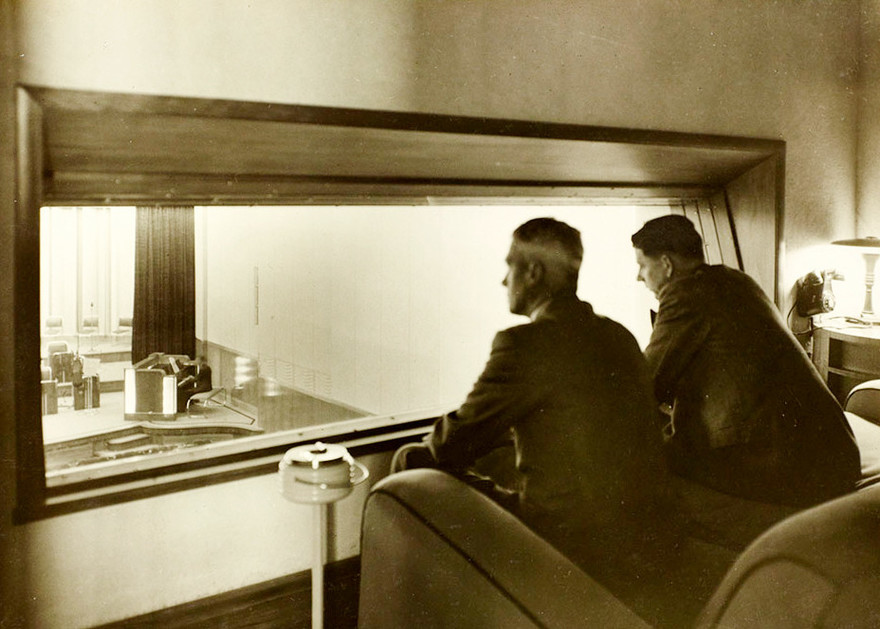
- Auckland Libraries Heritage Collections 915-Album-148-24
By the late 1980s Broadcasting House looked drab on the outside, and the interior was certainly well-worn. (A former RNZ director-general later described it to me, exasperatedly, as a “mausoleum”.) The building’s scale was now modest compared to the mirror-glass towers then being quickly built in central Auckland, in a demolish-and-develop frenzy led by the Chase Corporation. The RNZ board was encouraged to realise the potential of the land, and rent the building on Cook Street that would contain the Helen Young Studio.
Radio and technology had moved on, the reasoning went: the specs of the Radio Theatre were as obsolete as the Novachord (one of only 1000 ever built). The building was demolished in early 1990. In an evocative Listener piece describing the last live broadcast from the Radio Theatre, a few months earlier, Sheridan Keith wrote, “The Radio Theatre has closed. The two concert grand pianos have gone into storage, the sheet-glass balustrade with its etched design may be incorporated into the new premises. The Saturday night dance bands have packed up and gone long ago. So too have the crowds who used to come and listen for a free night’s entertainment, and a sense of occasion, at the Radio Theatre …
“It was a great send-off, but doesn’t it seem a pity?”
--
Read: 1ZB Radio Theatre – the jazz era fades
Read: 1ZM Radio Workshop: the rock invasion
The building photographs are by Doree and Sache – our thanks to Auckland Libraries Heritage Collections
Read about the architect of Auckland’s Broadcasting House, Ava Bartley
A rundown of the opening ceremony, at Nga Taonga
Read Alan Perrott on the demolition of His Majesty’s and other “monumental losses”, NZ Herald, 2009
A tour of a Novachord (works best without visuals)